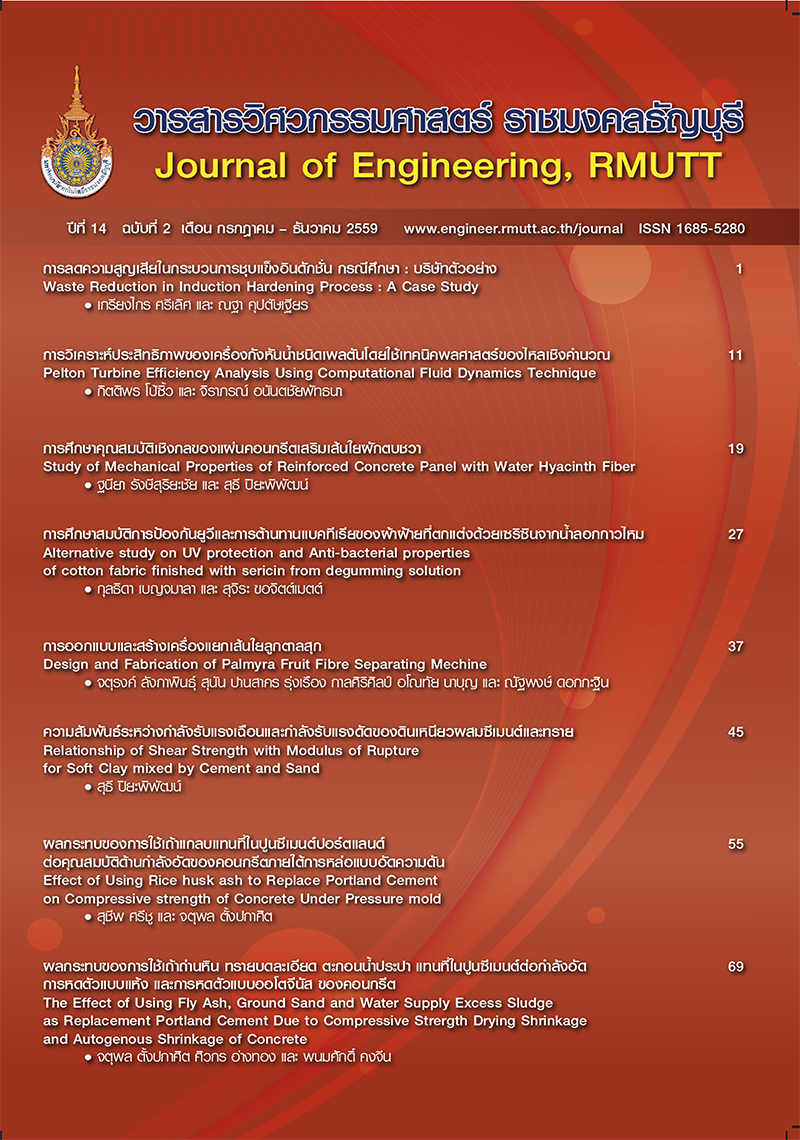Relationship of Shear Strength with Modulus of Rupture for Soft Clay mixed by Cement and Sand
Main Article Content
Abstract
The effect of sand mixed with soil cement has been investigated by laboratory tests as the unconfined compression test, the consolidated-undrained test and the third-point loading test. The soil sample is Bangkok clay and the sand used is Kanjanaburi sand, passing through sieve No. 4 but retained on sieve No. 10. The cement used is a portland cement type 1. For the procedures of specimen preparation, firstly the clay sample was mixed by sand of 0, 20 and 40% by dry weight of clay respectively. Then the aggregate as clay-sand mixer was mixed with cement of 10, 15 and 20% by dry weight. The water content of aggregate was adjusted to higher than the liquid limit of aggregate about 5%. Then the aggregate was mixed by cement and put it into 2 kinds of mould as 1) the cylinder mould with a diameter of 3.5 cm and a high of 7 cm for the unconfined compression test and the CU test and 2) the beam mould with the size of 7.5´7.5´35 cm3 for the third point loading test. The curing day used is 28 days. As results, the higher amount of sand, the higher unconfined compressive strength (qu), angle of internal friction and modulus of rupture. The relationships among the results of 3 types of testing with the quantity of sand mixed were demonstrated.
Article Details
The manuscript, information, content, picture and so forth which were published on Frontiers in engineering innovation research has been a copyright of this journal only. There is not allow anyone or any organize to duplicate all content or some document for unethical publication.
References
Broms, B. B., and Boman, P. O., 1979. “Lime column a new foundation method”. Journal of Geotechnical Engineering Division, ASCE, 105(GT4), pp. 539-556.
Bergado, D. T., Chai, J. C., Alfaro, M. C. and Balasubramaniam, A. S., 1994. Improvement Techniques of Soft Ground in subsiding and Lowland Environment. Balkema, Rotterdam, 222 p.
Taguchi T, Hino T, Suzuki M and Yamamoto T (2007) Consideration on applying of unconfined compressive strength evaluation of soil-cement column cured under stress to Saga lowland. Proceedings of the International Symposium on Geotechnical Engineering, Ground Improvement and Geosynthetics for Human Security and Environmental Preservation, Bangkok, Thailand, pp. 659–667.
Igaya Y, Hino T and Chai JC (2010) Behavior of trial embankments and the results of environmental monitoring for the Ariake sea coastal road project. Proceedings of the 7th International Symposium on Lowland Technology, Saga, Japan, 2010, 260–271.
Chai, J. C., Miura, N., Kirekawa, T. and Hino, T., 2009. “Settlement prediction for soft ground improved by columns”. Ground Improvement, Proceeding of Institute of Civil Engineers. UK. Vol. 162.
Pongsivasathit, S., Chai, J. C. and Ding W. (2012). “Consolidation settlement of floating-column-improved soft clayey deposit”. Ground Improvement, Proceeding of Institute of Civil Engineers, UK, Vol. 166, pp. 44-58.
ศุภสิทธิ พงศ์ศิวะสถิตย์, “การศึกษาคุณสมบัติทางวิศวกรรมของดินเหนียวผสมซีเมนต์และปูนขาว”, วิทยานิพนธ์ปริญญาวิศวกรรมศาสตรมหาบัณฑิต, สาขาวิศวกรรมโยธา, มหาวิทยาลัยเทคโนโลยีพระจอมเกล้าธนบุรี, พ.ศ.2543, หน้า 152-156.


